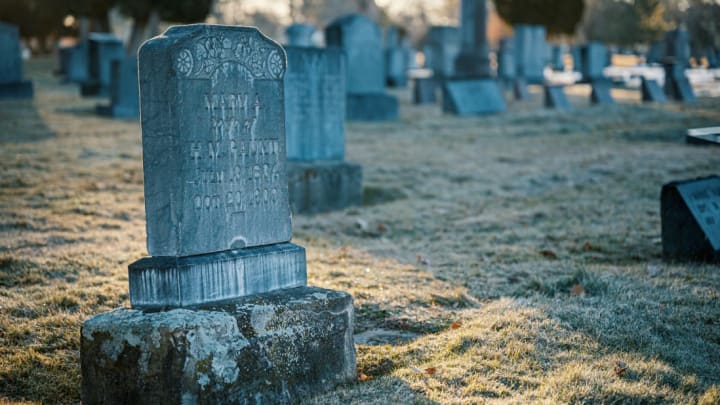Walk through any cemetery in the world and you’ll find a solemn landscape that honors loved ones that have passed on. Accompanying the inscriptions of names, dates, and family crests are some common cemetery symbols that crop up repeatedly on tombstones. If you’ve ever wondered what they could mean, take a look at some of the explanations behind the graveyard graphics.
1. Eye

If you feel someone may be looking at you in the cemetery, you might be near a tombstone engraving with an eye. Often surrounded in a burst of sunlight or a triangle, an eye typically represents the all-seeing eye of God and could denote that the decedent was a Freemason.
2. Clasped Hands

Seeing two hands clasped together can illustrate shaking hands or holding hands, depending on the position of the thumbs. A handshake can mean a greeting to eternal life. If clasped hands have different cuffs, it could indicate a bond between the deceased and a spouse or relative. If one hand is higher than the other, it could also mean that a person is being welcomed by a loved one or a higher power. The hand engraving grew into wide use during the Victorian era.
3. Dove

A dove usually symbolizes peace and the Holy Spirit, but its specific meaning depends on how the bird is posed. If it’s flying upward, the soul is ascending to heaven. If it’s flying down, it represents the Holy Spirit arriving at the baptism of Jesus Christ. If it’s holding an olive branch in its mouth, it refers to an ancient Greek belief that olive branches could ward off evil spirits.
4. Broken Chain

Medieval wisdom once held that a golden chain kept the soul in the body. In death, the chain is broken and the soul is freed. If the chain is unbroken and if it features the letters FLT (for Friendship, Love, and Truth), it probably means the deceased belonged to the Independent Order of Odd Fellows, a fraternal organization that seeks to promote charitable causes and offer aid.
5. Book

Was the deceased an avid reader? Maybe, but not necessarily. An open book on a tombstone might refer to a sacred text like the Bible, the “book of life,” or the person’s willingness to learn. If you see a dog-earned corner on the right side, it could indicate the person’s life ended prematurely and before their “book” was finished.
6. Finger Pointing Up

A hand with the index finger raised skyward is one of the more ambiguous symbols found in graveyards. It might be pointing to heaven, or indicate the fact that the decedent has risen from the land of the living.
7. Corn

A corn stalk on a tombstone means the deceased could have been a farmer; it used to be a custom to send corn instead of floral arrangements to a farmer’s family. It might represent other kinds of grain. Alternately, corn seeds can symbolize rebirth.
8. Scroll

A scroll engraved on a tombstone with both ends rolled up can indicate that part of life has already unfolded while the future is hidden.
9. Lamp

A lamp on a tombstone could speak to a love of learning or knowledge, or it might refer to how the spirit is immortal.
10. Camel

While this particular camel signifies the Imperial Camel Corps that occupied desert regions during World War I, a camel can also represent a long journey or a skilled guide—in this case, for the afterlife.
11. Hourglass

As you may have guessed, the hourglass symbolizes the march of time. An hourglass on its end may mean the deceased died suddenly, while a winged hourglass communicates how quickly time flies. It may also be construed as a message to the living—time is short, so don’t waste it.
